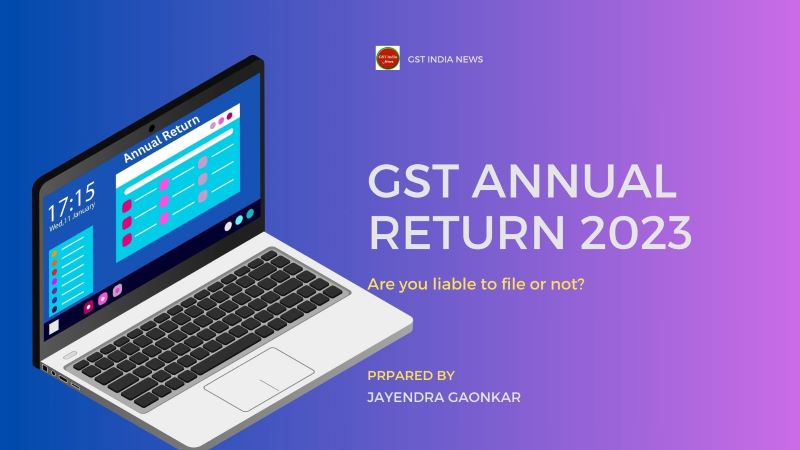GST has been implemented in India from 1st July 2017. Under the new GST regime, more than R 1.32 Cr businesses in India have been registered and issued GST registration. Barring a few exceptions, all entities having GST registration are required to file GST annual returns, irrespective of business activity sales or profitability during the return filing period.
GST registrants who obtained or held registration anytime during a given financial year are required to file annual returns for the said financial year. The annual return is a compilation return that includes all business transactions corresponding to a particular financial year. It consolidates the information furnished by a taxpayer in monthly /quarterly returns filed during the particular financial year.

Persons liable for filing Annual Return
As per Section 44 of CGST Act 2017, every registered person is required
to file an Annual Return except for the following:
(a) An Input Service Distributor;
(b) A person paying tax under Section 51 (i.e. TDS deductor);
(c) A person paying tax under Section 52 (i.e. TCS collector);
(d) A Casual Taxable Person; and
(e) A Non-Residential Taxable Person.
Types of Annual Return
As per Rule 80 of CGST Rules, 2017 following types of Annual Returns have been prescribed:
(a) FORM GSTR-9: This annual return is to be filed by all regular taxpayers (i.e. taxpayers who file regular returns in FORM GSTR-3B, GSTR-1, etc.).
(b) FORM GSTR-9A: This annual return is to be filed by all taxpayers who pay tax under Section 10 (i.e. taxpayers who file returns in FORM GSTR-4). In other words, the annual return in FORM GSTR-9A is to be filed by all composition taxpayers. IT may be noted that FORM GSTR 9A is not required to be filled w.e.f. the financial year 2019-20 due to the introduction of Annual FORM GSTR4.
(c) FORM GSTR-9B: This annual return is to be filed by all E-commerce operators required to collect tax at source under Section 52 (i.e. taxpayers who file regular returns in FORM GSTR-8).
(d) FORM GSTR-9C: This annual return is to be filed by every registered taxpayer whose Aggregate Annual Turnover during a financial year exceeds R 5 Cr. This is a reconciliation statement that is now required to be self-certified by the registered person.
Last date of filing Annual Return
As per Rule 80 of the CGST Rules, 2017, every registered person liable to file an Annual Return for every financial year is required to file the same on or before the 31st of December of the next financial year.
Accordingly, the last date for filing the Annual Return for FY 2022-23 is 31st December 2023.
It may be noted that the last date of filing the Annual Return for FY 2017-18 was extended up to 05th-07th February 2020; for FY 2018-19 up to 31st December 2020 and for FY 2019-20 up to 31st March 2021 and for FY 2020-21 upto 28th February, 2022.
Levy of late fee
As per Section 47(2) of CGST Act, 2017, any registered person who fails to furnish an Annual Return by the due date shall be liable to pay a late fee of R 100/- per day subject to a maximum of 0.25% of his turnover in the State or Union Territory. Similar provisions exist in respective SGST Acts, also. Therefore, effectively the late fee for delay in filing the Annual Return by the due date is R 200/- per day subject to a maximum of an amount calculated at 0.50% of his turnover in the State or Union Territory for the financial year 2022-23 onwards-
(i) For registered persons having an aggregate turnover of up to five crore rupees in the relevant financial year, a late fee in excess of Twenty-five rupees per day has been waived off, subject to a maximum of an amount calculated at 0.02 percent. of turnover in the State or Union territory.
(ii) For registered persons having an aggregate turnover of more than five crores rupees and up to twenty crore rupees in the relevant financial year, a late fee in excess of 50 rupees per day has been waived off, subject to a maximum of an amount calculated at 0.02percent of turnover in the State or Union territory. It may be noted that an equal amount of late fee is applicable under SGST /UTGST Acts as well.
Annual Returns made optional for small taxpayers
(a) The filing of annual returns in FORM GSTR-9 has been made optional for taxpayers having Aggregate Annual Turnover less than R 2 Cr for the financial years 2017-18, 2018-19, 2019- 20, 2020-21, and 2021-22 further, the registered person whose aggregate turnover in the financial year 2022-23 is upto two crore rupees, have been exempted from filing the annual return for the said financial year;
(b) The filing of annual returns in FORM GSTR-9A by composition dealers has been made optional for the financial years 2017-18, 2018-19, 2019-20, 2020-21, 2021-22, and 2022-23;
(c) The threshold of Aggregate Annual Turnover for filing of reconciliation statement in FORM GSTR-9C for the financial year has been increased from R 2 Cr to R 5 Cr.
Annual Return for the financial year 2022-23
For the financial year 2022-23, the Annual return forms have been notified vide Notification No. 38/2023-central tax dated 04.08.2023.
Details / Format of FORM GSTR-9 (Annual return for regular taxpayers)
The Annual Return FORM GSTR-9 has been divided into six parts containing 19 tables. It is mandatory to file all FORM GSTR-1 and FORM GSTR-3B for the financial year for which the return is to be filed before filing this return. It may be noted that additional liability for the FY 2017-18, FY 2018-19, FY 2019-20, FY 2020-21, FY 2021-22, and 2022-23, as the case may be, is not declared in FORM GSTR-1 or FORM GSTR-3B may be declared in this return. However, taxpayers cannot claim an Input Tax Credit through this return.
The structure of FORM GSTR-9 is detailed as given under
Part I: Basic Details
- Table 1: Financial Year
- Table 2: GSTIN
- Table 3A: Legal Name
- Table 3B: Trade Name (if any)
Part II: Details of Outward and Inward supplies made during the financial year
- Table 4: Details of advances, inward and outward supplies made during the financial year on which tax is payable.
- Table 5: Details of advances, inward and outward supplies made during the financial year on which tax is NOT payable
Part III: Details of ITC for the financial year
- Table 6: Details of ITC availed during the financial year.
- Table 7: Details of ITC reversed and ineligible ITC for the financial year
- Table 8: Other ITC related information
Part IV: Details of tax paid as declared in returns filed during the financial year
- Table 9: Details of tax paid as declared in returns filed during the financial year
Part V: Particulars of the transactions for the financial year declared in returns of the next financial year till the specified period
- Table 10: Supplies/tax declared through amendments (+) (net of debit notes)
- Table 11: Supplies/tax reduced through amendments (-) (net of credit notes)
- Table 12: Reversal of ITC availed during the previous financial year
- Table 13: ITC availed for the previous financial year
- Table 14: Differential tax paid on account of declaration in tables 10 and 11 above
Part VI: Other Information
- Table 15: Particulars of demands and refunds
- Table 16: Information on supplies received from composition taxpayers, deemed supply under Section 43, and goods sent on an approval basis.
- Table 17: HSN-wise summary of outward supplies
- Table 18: HSN-wise summary of inward supplies
- Table 19: Late fee payable and paid
Note: Towards the end of the return, the taxpayer is given the option to pay any additional liability declared in this form, through FORM DRC-03. A taxpayer has to select “Annual Return” in the drop-down provided in FORM DRC-03.
Details / Format of Form GSTR-9A (Annual return for composition taxpayers):
The Annual Return FORM GSTR-9A has been divided into five parts containing 17 tables.
The structure of FORM GSTR-9A is detailed as given under:
Part I: Basic Details
- Table 1: Financial Year
- Table 2: GSTIN
- Table 3A: Legal Name
- Table 3B: Trade Name (if any)
- Table 4: Period of composition scheme during the financial year
- Table 5: Aggregate Annual Turnover of the previous financial year
Part II: Details of Outward and Inward supplies made during the financial year
- Table 6: Details of outward supplies made during the financial year
- Table 7: Details of inward supplies on which tax is payable on reverse charge (net of credit/debit note) for the financial year
- Table 8: Details of other inward supplies for the financial year
Part III: Details of tax paid as declared in returns filed during the financial year
- Table 9: Details of tax paid as declared in returns filed during the financial year
Part IV: Particulars of the transactions for the previous FY declared in returns of April to September of the current FY or up to date of filing of Annual Return of the previous FY, whichever is earlier
- Table 10: Supplies/tax declared through amendments (+) (net of debit notes)
- Table 11: Inward supplies liable to reverse charge declared through amendments (+) (net of debit notes)
- Table 12: Supplies/tax reduced through amendments (-) (net of credit notes)
- Table 13: Inward supplies liable to reverse charge reduced through amendments (-) (net of credit notes)
- Table 14: Differential tax paid on account of the declaration made in Tables 10, 11, 12 & 13
Part V: Other Information
- Table 15: Particulars of demands and refunds
- Table 16: Details of credit reversed or availed
- Table 17: Late fee payable and paid
Note: Towards the end of the return, the taxpayer is given the option to pay any additional liability declared in this form, through Form DRC-03. The taxpayer has to select “Annual Return” in the drop-down provided in Form DRC-03.
Details / Format of Form GSTR-9C (Reconciliation Statement)
The reconciliation statement in FORM GSTR-9C has been divided into five parts containing 17 tables. It is mandatory to file all FORM GSTR-1, FORM GSTR-3B, and FORM GSTR-9 for the current financial year before filing this return. The reconciliation statement is to be filed for every GSTIN separately. The reference to the current financial year in this statement is the financial year for which the reconciliation statement is being filed.
The structure of FORM GSTR-9C is detailed as given under
Part I: Basic Details
- Table 1: Financial Year
- Table 2: GSTIN
- Table 3A: Legal Name
- Table 3B: Trade Name (if any)
- Table 4: Are you liable to audit under any Act?
Part II: Reconciliation of turnover declared in audited Annual Financial Statement with turnover declared in Annual Return (GSTR-9)
- Table 5: Reconciliation of gross turnover
- Table 6: Reasons for un-reconciled difference in annual gross turnover
- Table 7: Reconciliation of taxable turnover
- Table 8: Reasons for un-reconciled difference in taxable turnover
Part III: Reconciliation of tax paid
- Table 9: Reconciliation of rate-wise liability and the amount payable thereon
- Table 10: Reasons for un-reconciled payment of amount
- Table 11: Additional amount payable but not paid (due to reasons specified in Tables 6, 8, and 10 above)
Part IV: Reconciliation of Input Tax Credit (ITC)
- Table 12: Reconciliation of net Input Tax Credit (ITC)
- Table 13: Reasons for un-reconciled difference in ITC
- Table 14: Reconciliation of ITC declared in Annual Return (FORM GSTR9) with ITC availed on expenses as per audited Annual Financial Statement or books of accounts
Table 15: Reasons for un-reconciled difference in ITC
- Table 16: Tax payable on the un-reconciled difference in ITC (due to reasons specified in Tables 13 and 15 above)
Part V: Additional liability due to non-reconciliation
Table 17: Additional liability due to non – reconciliation
Note: Towards the end of the return, the taxpayer is given the option to pay any additional liability declared in this form, through FORM DRC03. The taxpayer has to select “Reconciliation Statement” in the drop-down provided in FORM DRC-03.



